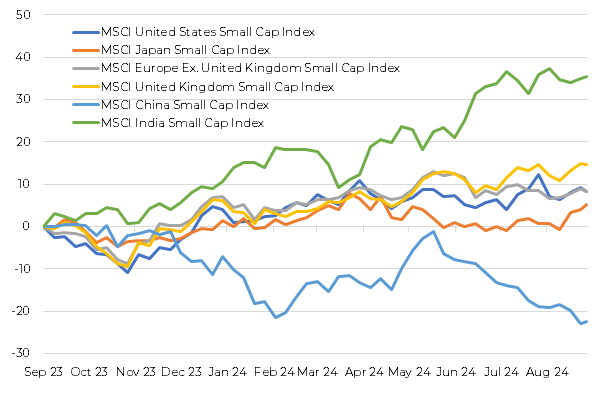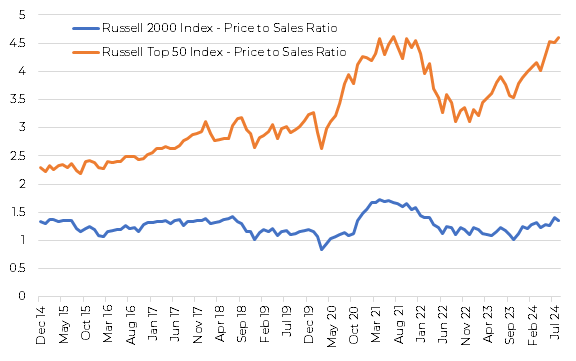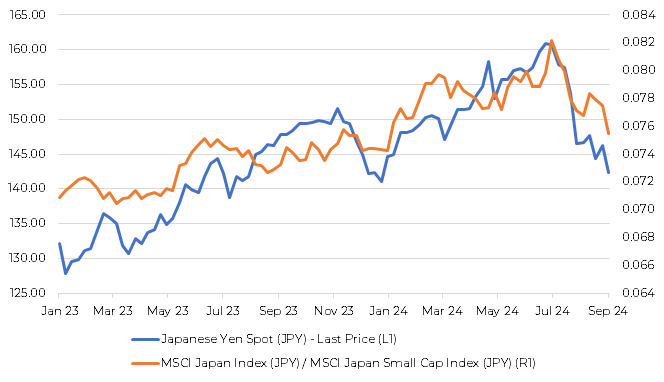Alan Rowsell, fund manager of the Premier Miton Global Smaller Companies Fund, looks at what has affected small caps around the world and whether the odds are in favour for a small cap resurgence
For information purposes only. The views and opinions expressed here are those of the author at the time of writing and can change; they may not represent the views of Premier Miton and should not be taken as statements of fact, nor should they be relied upon for making investment decisions.
Have you backed a winner?
The St. Leger Stakes, a horse race held in Doncaster, will run on the 14th September this year and, as followers of market folklore will know, this is traditionally the day for investors to return to the markets after the summer lull. Whether you follow the old adage “Sell in May and go away, don’t come back until St. Leger’s Day” or not, this can be a good time to review the portfolio and consider the outlook for the rest of the year and beyond. For those already invested in global small caps, we believe you have backed a winner. For those who have not, it looks as though the going is good, the form is improving and the odds are favourable – is it time to have a flutter?
Global small caps have delivered double-digit returns over the last year with most regional small cap indices sitting at or close to all-time highs. This has been driven by a modest recovery in the global economy leading to expectations for improved earnings growth in the future. Remember, sentiment was low a year ago when about a dozen major economies were in recession, including the UK and several European countries, which brought valuations down to attractive levels. Since then, economic growth has rebounded, inflation has fallen, and central banks have begun cutting interest rates which has allowed share prices to rally.
Regional Small Cap Performance over 1 Year in GBP

Source: Bloomberg 01.09.2023 – 27.08.2024. Past performance is not a reliable indicator of future returns.
The fastest horse has been India, where small caps have delivered the highest returns of any major country over the last year. A booming Indian economy with real GDP growing at an 8% clip has provided the tailwind for the strongest corporate earnings growth of any major market. Smaller companies tend to flourish in such an environment, so it is no surprise that they are outperforming larger companies.
Bringing up the rear is China which has seen share prices decline over the last twelve months. The Chinese economy is in recession as it faces headwinds from a real estate bust, increasing protectionism and tepid demand for its exports. Being more domestically oriented, smaller companies tend to suffer more than larger companies in these conditions which has been the case in China.
Middle of the pack are a lot of countries seeing low but positive economic growth, modest earnings growth and similar share price returns. The best of this middling group has been the UK where the economy has returned to growth and is doing better than the rest of Europe for the first time in a while. After a tough 2022 and 2023, UK small caps have perked up and have delivered share price returns ahead of Europe, the US and Japan over the last year. UK small caps have also slightly outperformed large caps, consistent with the historical pattern of small cap outperformance when economic growth and earnings start to improve.
The story in the US is different. While small caps have delivered positive returns, just behind those in the UK, they have lagged US large caps. This is despite a stronger economy which is typically good for small caps. The reason is the powerful performance of a handful of mega caps that now dominate US large cap indices. The likes of Apple, Microsoft, Nvidia, Google, Meta and Amazon have been big beneficiaries of digitalization, a trend that accelerated during the pandemic and it is now hoped that AI will provide the next leg of growth.
Whether mega cap outperformance can continue is probably the biggest question in equity markets right now. Strong earnings growth has led to significant valuation expansion over the last few years so the bar is higher. The key will be whether they can continue to outgrow smaller companies. The latter should see a pickup in earnings growth as they recover from the downturn while the mega caps may experience an earnings drag from heavy investment into AI.
US mega cap valuations have expanded significantly relative to US small caps

Source: Bloomberg 31.12.2014 – 28.08.2024
Price action over the summer suggests the market is beginning to sit up and take note. July saw one of the sharpest rotations ever out of mega caps into small caps with a further boost coming in August following Jerome Powell’s Jackson Hole speech. This confirmed that interest rate cuts will start in September which will help smaller companies. US small caps have been a little slow out of the gates this cycle, but they may be the horse to consider from here!
Lagging the US but still with positive returns are Japanese small caps. Earnings growth has been quite good for much of the last year but has started to soften in recent months as the Japanese economy slipped back into a technical recession while wage inflation remained quite high. Meanwhile, Japanese large caps, which tend to have a higher overseas exposure, have benefited from a falling yen boosting the value of their overseas earnings when translated back into local currency. Japanese small caps, on the other hand, are more focused on the domestic economy so their earnings have not had the same benefit. Another factor has been the Tokyo Stock Exchange’s initiative to improve capital efficiency and shareholder value. This has had a greater impact on older, less efficient large caps than newer, more dynamic small caps.
Japanese large caps have benefited from a weak yen

Source: Bloomberg 06.01.2023 – 06.09.2024. Past performance is not a reliable indicator of future returns.
All told, Japanese small caps have lagged behind large caps but this sets up a buying opportunity. Small caps look cheap after a derating with P/E multiples now below their pre-pandemic range and at a discount to large caps. At the same time, the headwinds mentioned above are turning into tailwinds. The outlook for the Japanese economy is starting to brighten with economic growth forecast to turn positive in coming quarters. The yen has bottomed and appears to be in an uptrend with the Bank of Japan now tightening monetary policy while other central banks ease. Finally, the easy money has been made in large cap value stocks on the promise of reform and improved capital efficiency. Now they need to deliver results to justify the re-rating which will prove more difficult. Ultimately, profits drive share prices and it is small caps that have the better track record.
Over the long term, global small caps have outperformed large caps because they deliver higher earnings growth. However, they are cyclical as their profits tend to be more sensitive to the economy. Past cycles show that the typical pattern is for small caps to underperform during an economic downturn, bottom during recession and then outperform sharply as the recovery unfolds. Other factors can disrupt this pattern such as strong earnings growth from a handful of mega caps or a currency move, as discussed above. But the odds looks to be in your favour if you invest in small caps at either the beginning of an economic upturn or when economic growth and corporate profits are accelerating.
Over the last year, we have seen this play out in India where the economy and profit growth have accelerated to being the strongest in the world. We have also seen it to a lesser extent in the UK as it exited recession and began a modest economic recovery. Meanwhile in China, its economy remains in a downturn and so it is no surprise that small caps have declined.
Our approach to global small cap investing is to focus primarily on the rate of change in earnings growth relative to expectations at the company level but to also consider the economic cycle of the country within which the company operates, as well as industry dynamics. It is a multi-level approach that means we like to invest in stocks where the company, industry and country level drivers are all moving in a positive direction.
With that as our framework, we see more small cap investment opportunities emerging as the headwinds of recent years turn into tailwinds. The global economy is generally moving from a downturn to a recovery which should benefit smaller companies more than large. The gap in earnings growth between US mega caps and smaller companies is closing. The Japanese yen is rising which will benefit domestically focused smaller companies. All of this is happening while small caps trade at low valuations and a discount to large caps. We hope you enjoy the racing on St. Leger’s Day and backed a winner – we suggest one to consider for the future could be global small caps!

